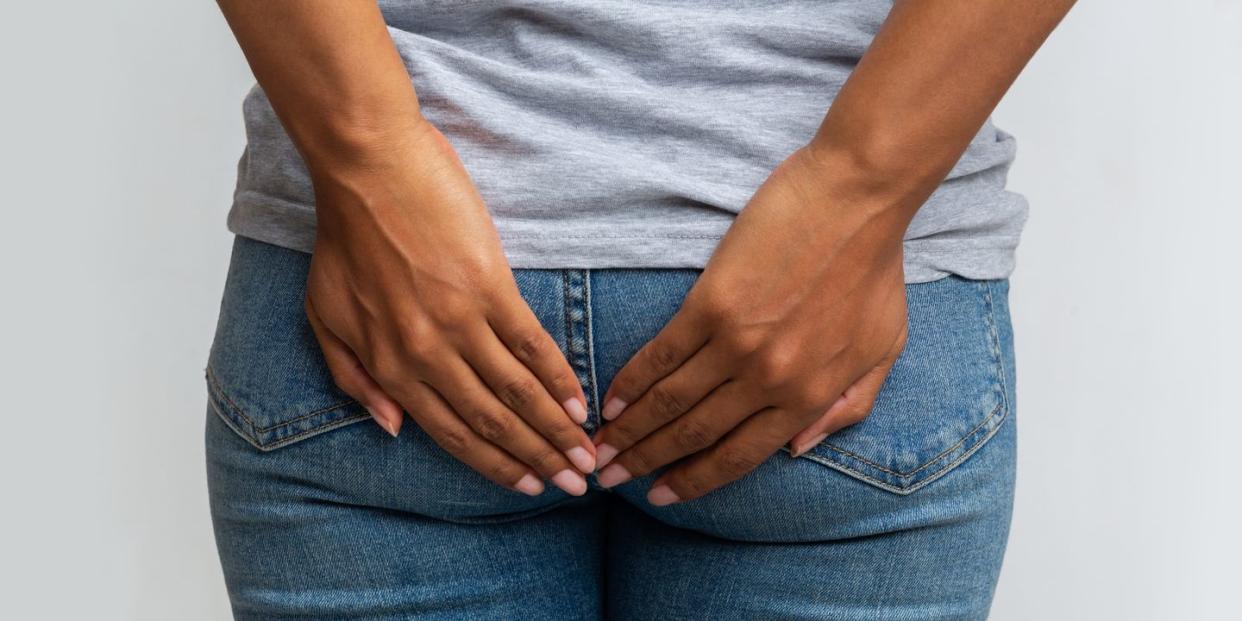Worried about a small lump on your anus?

If you’ve found a small and often dark or black coloured lump on the outside of your anus that looks a bit like external piles, it is most likely a perianal haematoma.
A perianal haematoma can be distinctly uncomfortable, and may leave you feeling worried or embarrassed, as well as in pain. But if you’re unsure what to do if it hurts when you poo, try not to panic.
We speak to Dr Riccardo Di Cuffa, GP and founder of Your Doctor, for his expert advice on how to spot and treat a perianal haematoma:
What is a perianal haematoma?
A perianal hematoma is a blood blister that collects in the tissue surrounding the anus, similar to when you trap or hit your thumb with a hammer. It is usually caused by a ruptured or bleeding vein that occurs when the bowels are opened, and it only occurs on the outside of the anus, as opposed to being an internal issue.
‘A perianal haematoma is a collection of blood in the tissues that surround the anus, as a result of a ruptured vessel or vein,’ explains Dr Di Cuffa. ‘It usually forms a clot under the skin and can look a bit blue or black. It can also be painful, particularly when passing a stool.’
Perianal haematoma causes
There are a number of different reasons why people might get a perianal haematoma. ‘These include strong coughing, which raises the pressure in the vessels around the anus, or constipation, as straining and hard stools can cause vessels to rupture,’ reveals Dr Di Cuffa.
'Medical procedures, such as scopes, can put you at extra risk of bleeding or trauma, as can pregnancy, because as the foetus grows, the uterus puts pressure on the vessels around the anus. Not getting enough exercise, having a sedentary lifestyle and also just sitting down a lot can put pressure on your anus, but then conversely, so can strenuous lifting.’
Perianal haematoma symptoms
The main symptoms of a perianal haematoma include the following:
A black or blue lump on the outside of the anus
Pain, especially when going to the toilet
Possible bleeding after passing a stool (if it tears or bursts)
‘There are, however, other conditions that can cause the same symptoms, such as haemorrhoids,’ says Dr Di Cuffa. ‘So if you have a lump or bulging of the skin around the anus, or pain, which can range from mild to severe, it’s best to see your GP.’
Perianal haematoma home treatments
Perianal haematomas is easily treatable and usually goes away of its own accord. ‘The vast majority of perianal haematomas will settle on their own with no intervention needed,’ reassures Dr Di Cuffa. 'But if you are concerned, visit your GP to have it checked out.’
In the meantime, Dr Di Cuffa recommends trying these simple measures to help alleviate any pain or discomfort:
• Take over-the-counter painkillers, such as paracetamol, when required.
• Apply a cool compress to the site.
• Use a doughnut-shaped cushion, to help alleviate pressure when you sit down.
• Eat plenty of fibre and drink more water, to help soften your stool and avoid straining.
• Avoid strenuous activities or heavy lifting until the problem has resolved.
When to see your doctor
If the symptoms persist, make an appointment with your GP.
‘Your doctor will examine the area and, in some cases, may recommend that the clot is incised after numbing the area, which will allow the clot to be released,' says Dr Di Cuffa. 'The wound will then need to be cleaned and will heal over time.’
Last updated: 28-09-2020
You Might Also Like


